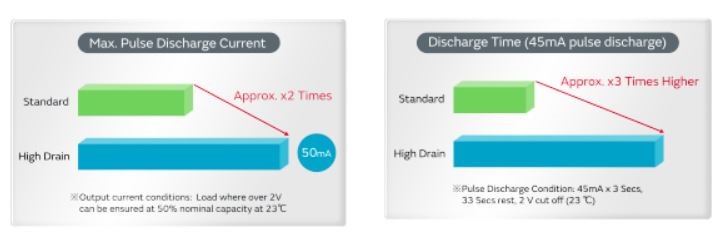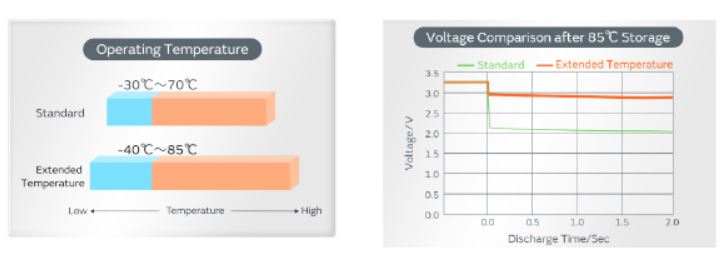Murata Manufacturing Co., Ltd. (Head Office: Nagaokakyo-shi, Kyoto; President: Norio Nakajima) announces development of new High Drain and Extended Temperature batteries as part of its lithium coin battery line-up. These products are now in mass-production, samples are available upon request.
1. Development Background
Application of lithium coin batteries is widespread, ranging from the Internet of Things (IoT), automotive, medical to factory automation (FA) markets. Traditionally, lithium coin batteries have been used to provide backup power for low drain devices. However, the demand for lithium coin batteries as the main power source are recently drastically increasing with growing the IoT market. In order to support such customer needs, in addition to current standard and heat resistant lithium coin batteries, Murata has newly developed High Drain and Extended Temperature lithium coin batteries by leveraging its heat resistant battery engineering design and utilization technologies that have accumulated over the past many years of production.
The High Drain lithium coin batteries are ideal for tracking devices for logistics and asset management by adopting Low Power Wide Area (LPWA) networks such as Semtech’s LoRa Technology and SIGFOX as well as for outdoor infrastructures, FA control systems and environment monitoring sensors. The Extended Temperature lithium coin batteries are designed mainly for automotive devices and outdoor IoT systems (including smart meters and FA control systems) and can also be used as an alternative smaller and thinner solution to conventional lithium cylindrical batteries.
Murata’s Lithium Coin Battery Specification



2-1. Characteristics of High Drain lithium coin batteries

- • Double the maximum pulse discharge current of standard lithium coin batteries (50mA)*1
- • Can also be used for LPWA communication devices including LoRA, which has been difficult by standard lithium coin batteries due to its high peak current requirements*2
- • Triple the discharge time*3 compared to standard lithium batteries, enabling longer battery life and less battery replacement requirements
*1 Maximum current of pulsed discharge (3 seconds) at 2V or higher discharged with 50% nominal capacity at an ambient temperature of 23ºC
*2 Peak current may vary according to the using environment and conditions of use
*3 Pulsed discharge at 45mA for 3 seconds and no discharge for 33 seconds at an ambient temperature of 23ºC
Mr. Vivek Mohan, Director of IoT, of Semtech Corporation, a member of LoRa Alliance and a joint developer of LoRaWAN modules with Murata, comments as follows:
"Semtech's LoRa RFIC SX1261 requires approx. 25mA power supply current at 3V supply voltage and 42mA at 1.8V to generate typical LPWA output at 20mW. The LoRaWAN standard defines the maximum transmit time at 3 seconds. Murata’s new High Drain lithium coin batteries will support, up to 50mA and 3 seconds of current, making it a promising solution for LoRaWAN-compatible small sensor nodes."
2-2. Characteristics of Extended Temperature lithium coin batteries

- • The compatible operating temperature for electronic parts and ICs*4 ranges between -40ºC and 85ºC
- • The voltage drop is minimal compared to the standard lithium coin batteries even when stored for over 100 days at 85ºC
- • More affordable than the heat resistant lithium coin batteries, providing better price-performance
- • CR3677X, the largest capacity Extended Temperature*5 lithium coin battery, delivers the largest capacity in lithium coin battery form factor*6, thereby enabling smaller and thinner device design flexibility
*4 The operating temperature range of standard lithium coin batteries is −30ºC to 70ºC
*5 Shipment of mass-produced CR3677X is scheduled to start at the end of 2019
*6 Murata Research, September 28, 2018
New Product Lineup
| Type | Model number | Nominal voltage | Operating temperature | Nominal capacity* | Recommended continuous discharge current | Maximum pulse discharge current** | Diameter | Height | Weight |
High Drain |
CR2032R |
3.0V |
-30 to 70ºC |
200mAh | ≦3mA | 50mA | 20.0mm | 3.2mm | 3.0g |
High Drain |
CR2450R | 3.0V | -30 to 70ºC | 500mAh | ≦3mA | 50mA | 24.5mm | 5.0mm | 6.2g |
Extended Temperature |
CR2032X | 3.0V | -40 to 85ºC | 220mAh | ≦1mA | 30mA | 20.0mm | 3.2mm | 3.0g |
Extended Temperature |
CR2450X | 3.0V | -40 to 85ºC | 600mAh | ≦1mA | 30mA | 24.5mm | 5.0mm | 6.2g |
Extended Temperature |
CR2477X | 3.0V | -40 to 85ºC | 1000mAh | ≦1mA | 30mA | 24.5mm | 7.7mm | 9.5g |
Extended Temperature |
CR3677X | 3.0V | -40 to 85ºC | 2000mAh | ≦1mA | 80mA | 36.5mm | 7.7mm | 20g |
* Capacity when discharged at standard discharge current (temperature: 23ºC, end of discharge voltage: 2.0V)
** Current for maintaining minimum 2V voltage with pulsed discharge of 3 seconds and 50% nominal capacity discharged (ambient temperature 23ºC)
Data is for reference purpose only
Murata is committed to providing a one-stop electronic component and solution for the IoT market. In September 2017, Murata added Sony’s battery business operations, bringing in Sony’s 40 years of battery manufacturing experience and expertise, into its product offerings in an effort to better serve customers’ growing and diversified needs. Murata will continue to contribute to the growth of IoT market.

